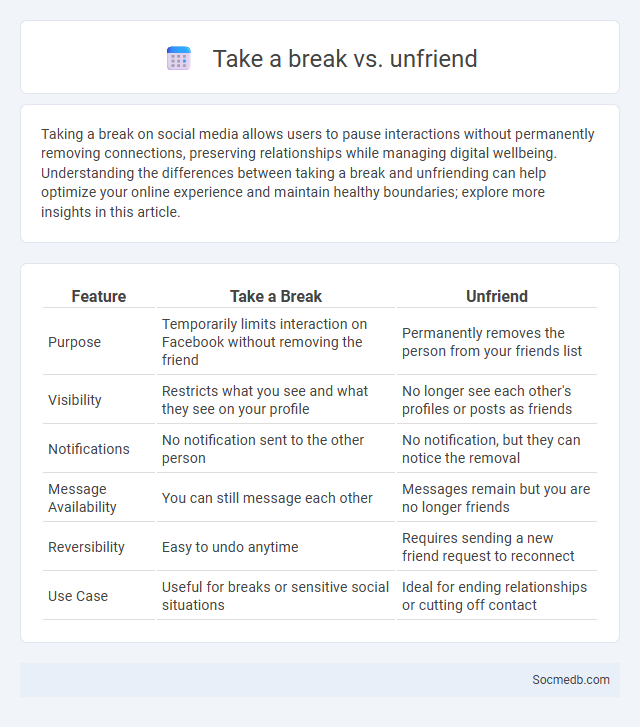
Photo illustration: Take a Break vs Unfriend
Taking a break on social media allows users to pause interactions without permanently removing connections, preserving relationships while managing digital wellbeing. Understanding the differences between taking a break and unfriending can help optimize your online experience and maintain healthy boundaries; explore more insights in this article.
Table of Comparison
| Feature | Take a Break | Unfriend |
|---|---|---|
| Purpose | Temporarily limits interaction on Facebook without removing the friend | Permanently removes the person from your friends list |
| Visibility | Restricts what you see and what they see on your profile | No longer see each other's profiles or posts as friends |
| Notifications | No notification sent to the other person | No notification, but they can notice the removal |
| Message Availability | You can still message each other | Messages remain but you are no longer friends |
| Reversibility | Easy to undo anytime | Requires sending a new friend request to reconnect |
| Use Case | Useful for breaks or sensitive social situations | Ideal for ending relationships or cutting off contact |
Understanding the Difference: Take a Break vs Unfriend vs Unfollowing
Taking a break on social media means temporarily limiting interactions without severing connections, allowing users to pause content visibility while maintaining relationships. Unfriending removes a user from your friends list or contacts, effectively ending direct social interaction and content sharing with that person. Unfollowing keeps the connection intact but stops the user's posts from appearing in your feed, offering a less drastic way to reduce content exposure without complete disconnection.
Psychological Impact of Online Boundaries
Establishing online boundaries on social media significantly reduces anxiety and stress by limiting exposure to negative content and social comparison. Clear personal limits enhance emotional well-being and foster a healthier digital experience by preventing information overload and protecting privacy. Consistent boundary-setting correlates with improved mental health outcomes, including reduced feelings of loneliness and increased self-esteem.
When to Choose "Take a Break
You should choose "Take a Break" on social media when interactions with certain individuals become emotionally overwhelming or negatively impact Your mental health. This feature temporarily limits visibility and reduces contact without unfriending or blocking, providing a controlled way to regain emotional balance. Using "Take a Break" allows you to maintain boundaries while continuing to navigate social platforms safely.
Benefits and Drawbacks of "Unfriend
Unfriending on social media can enhance mental well-being by removing toxic or unproductive interactions, fostering a healthier online environment. However, it may also lead to social isolation, miscommunication, or strained relationships, especially if done without clear explanation. Balancing digital boundaries with empathy is crucial for maintaining meaningful connections while protecting personal space.
The Subtlety of "Unfollowing" Connections
Unfollowing on social media subtly reshapes your digital environment, allowing you to curate content that aligns with your interests and mental well-being. This action maintains connections without severing ties, preserving relationships while reducing unwanted noise in your feed. Your social media experience becomes more personalized, enhancing engagement with relevant updates and meaningful interactions.
Social Media Etiquette: Navigating Relationship Changes
Navigating relationship changes on social media requires careful attention to privacy and respect for all parties involved to maintain trust and avoid misunderstandings. You should adjust your online interactions thoughtfully, such as updating relationship statuses or managing tagged posts, to reflect your new situation while considering others' feelings. Clear boundaries and respectful communication on platforms like Facebook, Instagram, and Twitter help preserve dignity and prevent conflicts during sensitive transitions.
Privacy Control and Content Visibility
Social media platforms offer advanced privacy control settings that let you customize who can see your posts, ensuring your personal information remains secure. By managing content visibility options, you can restrict access to specific friends, groups, or public audiences to maintain your desired level of privacy. Regularly reviewing and updating these settings helps protect your online presence from unwanted exposure or data misuse.
Reconnecting After a Digital Break
Reconnecting after a digital break on social media involves gradually re-engaging with platforms like Facebook, Instagram, and Twitter to rebuild online presence and social connections. Prioritizing meaningful interactions and authentic content helps restore trust and fosters genuine engagement with followers. Leveraging updated app features and privacy settings ensures a secure and personalized experience during the re-entry phase.
Emotional Considerations Before Unfriending
Before unfriending someone on social media, consider the emotional impact on both you and the other person, as online connections often reflect real-life relationships. Reflect on your feelings and the reasons behind your decision, ensuring it aligns with your emotional well-being and boundaries. Your thoughtful approach can prevent unnecessary misunderstandings and maintain healthier digital interactions.
Best Practices for Managing Social Media Relationships
Effective social media relationship management involves timely responses to comments and messages, fostering genuine interactions with followers to build trust and loyalty. Utilizing analytics tools helps identify audience preferences and tailor content strategies accordingly, enhancing engagement and retention rates. Consistent brand voice and transparent communication further strengthen connections, transforming casual followers into brand advocates.
 socmedb.com
socmedb.com